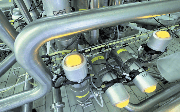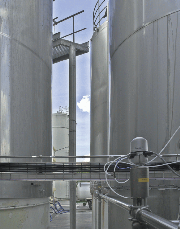 Advertisement feature
Advertisement feature
Fromagerie Bel has achieved standardisation across process valves with Bürkert fieldbus-enabled universal control heads
Tetra Pak has provided Fromagerie Bel, at its Cléry-le-Petit site, with a flow management system that adds an extra protein constituent to milk collected locally in the Meuse area of France. The protein is required to guarantee the consistent quality of cheese subsequently produced from the milk. Control of the flow management system is provided by 180 fieldbus controlled valves, all of which are equipped with Bürkert 8681 series universal control heads. The 8681 series was selected for its universal application, optimal reliability and safety, and for the fact that it is particularly suited to aseptic environments. The unit offers a hygienic design, IP65/67 protection rating and has good resistance to chemical cleaning products. In addition, Bürkert’s patented magnetic activation system provides easy and safe access to the control head for preventive maintenance.
Fromagerie Bel is a leader in agrifood production, marketing its five-star brands (La vache qui rit, Mini Babybel, Kiri, Leerdammer, Boursin), as well as more than 20 local brands with a strong image, on five continents. The Group employs 11,300 people, has a turnover of 2.4 billion euros and has 25 production sites throughout the world.
Recently, Fromagerie Bel approached Tetra Pak regarding a project to enrich the protein value of milk at the Group’s Cléry-le-Petit site, which processes 110 million litres of milk and produces 12,000 tonnes of cheese per annum. The project had to be undertaken because milk collected in the Meuse region is quite low in proteins, which makes it just about usable for cheese production. Moreover, although the milk, which represents 50% of the price of cheese, is not sufficiently rich in proteins, a more significant quantity of lactoserum, with no added value, still remains, at the expense of the cheese factory.
To solve this problem, new vats were installed with flow management handled by agrifoodstuff valves controlled by Bürkert series 8681 control heads in a fieldbus-enabled distributed control system.
 The 8681 units are universally adaptable control heads designed specifically for decentralised automation systems using ASI communications. They can be used on most process valves (globe, butterfly, diaphragm and ball), delivering the required standardisation across the Cléry-le-Petit site, and offering control and diagnostic safety thanks to the remote visualisation of the positions of the respective valves. The 8681 units execute all pneumatic commands, position feedback functions and diagnostics and, depending upon the process valve, can control up to three pneumatic chambers separately.
The 8681 units are universally adaptable control heads designed specifically for decentralised automation systems using ASI communications. They can be used on most process valves (globe, butterfly, diaphragm and ball), delivering the required standardisation across the Cléry-le-Petit site, and offering control and diagnostic safety thanks to the remote visualisation of the positions of the respective valves. The 8681 units execute all pneumatic commands, position feedback functions and diagnostics and, depending upon the process valve, can control up to three pneumatic chambers separately.
In addition to their decentralised control benefits, the control heads offered the Cléry-le-Petit project the advantage of ease of installation and checking. The respective positions of the process valve are verified by the control head via an inductive analogue position sensor. After installing the control head on the valve actuator, the positions of the valve are determined automatically by a fast, reliable ‘teach-in’ function, which eliminates any need for configuration and manual adjustments. In addition, start-up times are reduced by simple self-setting limit switches in what is an Autotune function.
In operation, the series 8681 control head provides maximum integrity with IP65/67 ingress protection, and via its magnetic control key, which prevents the control head from being opened on site after commissioning. The 8681 enables instant visual diagnostics of valve status by colour coding (Open/Closed/Error) that can be seen from up to100 metres. Complementing this facility, a large format visual luminous colour display unit signals valve positions, operating errors, anomalies in communication with the bus, and mechanical blockages in the valves (et al). Internal diagnostic data, such as the number of cycles achieved for servicing of the valve seals, or operating errors, are therefore signalled visually and archived in the memory of the control head, where they can be read in detail via a service interface using Bluetooth, SmartPhone or PC.
Also aiding operational flexibility of the Type 8681 at Cléry-le-Petit is a feature that allows the switching speed of each driver chamber to be set individually for both directions of movement: this is by means of a restrictor function integrated into the pilot valve.
In addition, a non-return valve prevents faulty switching of the process valves due to back pressure. Independently of the power suppl y, each pilot valve can be switched manually by means of a mechanical hand control. This patented magnetically-coded manual operation allows switching of the main actuator from outside a completely enclosed device – ensuring full IP protection also during maintenance on the process valves.
y, each pilot valve can be switched manually by means of a mechanical hand control. This patented magnetically-coded manual operation allows switching of the main actuator from outside a completely enclosed device – ensuring full IP protection also during maintenance on the process valves.
Commenting upon the success of the Cléry-le-Petit project, a Bürkert spokesman said that: “Decentralised automation of process valves using the 8681 universal control head delivers cost savings through plant standardisation, and provides fast, economical and safe control. Decentralisation also delivers a clearly structured and easy-to-monitor system design that increases operational reliability. Compared to actuation by pilot valves in a central switching cabinet, control heads mounted directly on the actuator offer clear advantages in terms of planning, installation, start-up and maintenance. This is because the design is simplified and switching times for the process valves and the consumption of control air are minimised by the extremely short connections between the pilot valve in the control head and the pneumatic actuator.”
Bürkert
T: 01453 731 353